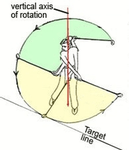- Joined
- Dec 23, 2015
- Messages
- 7,631
- Reaction score
- 4,260
Actually, this is one thing that is highly variable among players at the highest level. If you want to check your swing for good/bad characteristics here are some places to start.
Some of the most common backswing faults are:
1 - Snatching the club head to the inside
2 - Lifting the club handle up and down in front of you
3 - Manipulating the club with the hands (as opposed to swinging the club back)
Generally speaking...
1 - You want the club head to be slightly outside your hands when the shaft reaches parallel to the ground, and parallel to the ground should occur when the hands are about hip high going back
2 - At chest high your hands should still be in front of your back should be facing the target line (thus your chest will have rotated around your spine about 90 degrees from setup)
3 - Think wide going back, especially in relation to your lead hand (allow the back arm to fold naturally, but the hand of the lead arm should be far from your trail ear at the top of the backswing)
Some of the most common backswing faults are:
1 - Snatching the club head to the inside
2 - Lifting the club handle up and down in front of you
3 - Manipulating the club with the hands (as opposed to swinging the club back)
Generally speaking...
1 - You want the club head to be slightly outside your hands when the shaft reaches parallel to the ground, and parallel to the ground should occur when the hands are about hip high going back
2 - At chest high your hands should still be in front of your back should be facing the target line (thus your chest will have rotated around your spine about 90 degrees from setup)
3 - Think wide going back, especially in relation to your lead hand (allow the back arm to fold naturally, but the hand of the lead arm should be far from your trail ear at the top of the backswing)




